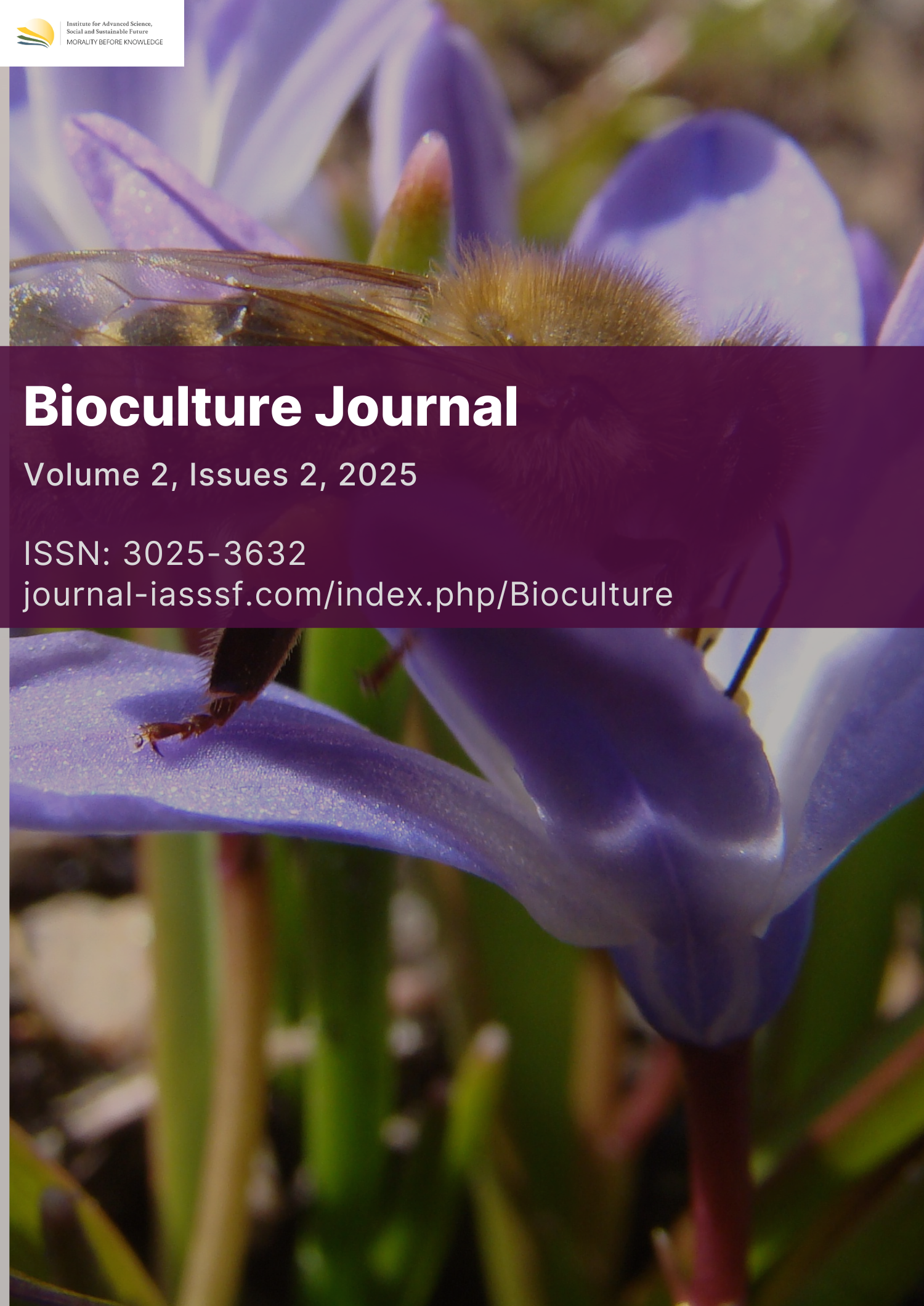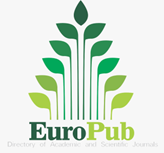The relationship between nitrate and phosphate nutrients in substrates with seagrass density: Implications for marine ecosystem sustainability
DOI:
https://doi.org/10.61511/bioculture.v2i2.2025.1504Keywords:
seagrass density, nitrate, phosphate, substrate, Pajenekang IslandAbstract
Introduction: Water conditions that greatly affect the density of seagrass species are the substrate fraction and nutrient content of the base substrate where the seagrass grows. This is important because seagrass utilizes dissolved nutrients in the waters and nutrients on the substrate for the production process. This study aims to determine the relationship between nitrate and phosphate nutrients on the substrate with seagrass density in Pajenekang Island, Liukang Tuppabiring District, Pangkep Regency, South Sulawesi. Methods: Data sampling of seagrass was carried out at north and west station using the line transect method where the data taken included seagrass frequency, cover, and density. Meanwhile, data collection of nitrate and phosphate nutrients on the substrate used a random sampling method and analysis with macro nutrien determination Morgan-Wolf extract. Findings: The results of study indicated that the seagrass density values in Pajenekang Island have various values, with the average seagrass density at the west station are 275 stands/m² and 356 stands/m² at the north station. The nutrient content on substrate in Pajenekang Island is low range when compared the result of other studies. Nitrate (0.36 ppm) and phosphate (0.49 ppm) at west station was significantly lower (P<0.05) compared to nitrate (0.49 ppm) and phosphate (0.64 ppm) at north station. The results of the Pearson correlation analysis among nitrate content and seagrass density on Pajenekang Island showed a negative relation with moderate correlation (-0.496*). Meanwhile, Pearson correlation analysis of phosphate content showed a negative relation by showing no relation (-0.166). This can be explained that there are other factors that effect on seagrass density in research location. Conclusion: It can be concluded that the seagrass density at Pajenekang Island varies. The average seagrass density at the western station is 275 individuals/m², while at the northern station, it is 356 individuals/m². Novelty/Originality of this article: The novelty of this research lies in analyzing the relationship between nitrate and phosphate nutrient content in the substrate and seagrass density on Pajenekang Island, which has not been widely studied in this region.
References
Angellica, C., Septiya, C. A., Klarisa, F. T., Mulyaningsih, L., Huzaifi, M., Rasyid, F. M., Razan, H. F., Kelana, S. A., & others. (2024). Interspecific association of seagrass Enhalus acoroides with macrozoobenthic in seagrass meadow ecosystems in the eastern part of Pramuka Island. Jurnal Kelautan, 17(2), 138. https://doi.org/10.21107/jk.v17i2.25096
Anggraini, K. (2008). Mengenal ekosistem perairan. Grasindo.
Dahuri, R., Rais, S., Ginting, M., & Sitepu. (2001). Pengelolaan sumber daya wilayah pesisir dan lautan secara terpadu. Pradnya Paramita.
Den Hartog, J. C. (1970). The sea-grasses of the world. North-Holland Publishing Company.
Erftemeijer, P. L. A., & Middelburg, J. (1993). Sediment-nutrient interaction in tropical seagrass beds: A comparison between a terrigenous and a carbonate sedimentary. Marine Ecology Progress Series, 102, 187-198. https://doi.org/10.3354/meps102187
Fahmi, A., Syamsudin, Utami, S., & Radjagukguk, B. (2010). Pengaruh interaksi hara nitrogen dan fosfor terhadap pertumbuhan tanaman jagung (Zea mays L.). Berita Biologi, 10(3), 297-304. http://dx.doi.org/10.14203/beritabiologi.v10i3.744
Farges, B., Poughon, L., Roriz, D., Creuly, C., Dussap, C. G., & Lasseur, C. (2012). Axenic cultures of Nitrosomonas europaea and Nitrobacter winogradskyi in autotrophic conditions: a new protocol for kinetic studies. Applied biochemistry and biotechnology, 167(5), 1076–1091. https://doi.org/10.1007/s12010-012-9651-6
Hamuna, B., Rosye, H. R., Suwito, H. K., & Alianto. (2018). Kajian kualitas air laut dan indeks pencemaran berdasarkan parameter fisika-kimia di perairan Distrik Depapre, Jayapura. Jurnal Ilmu Lingkungan, 37. https://doi.org/10.14710/jis.%25v.%25i.%25Y.633-644
Handayani, D. R., Armid, & Emiryati. (2016). Hubungan kandungan nutrien dalam substrat terhadap kepadatan lamun di perairan Desa Lalowaru, Kecamatan Moramo Utara. Jurnal Sapa Laut, 1(2), 42-53. http://dx.doi.org/10.33772/jsl.v1i2.929
Hemminga, M., & Duarte, C. M. (2000). Seagrass ecology. Cambridge University Press.
Hossain, M. S., Bujang, J. S., Zakaria, H. M., & Hashim. (2015). Application of Landsat images to seagrass areal cover change analysis for Lawas, Terengganu, and Kelantan of Malaysia. Continental Shelf Research, 110, 124-148. https://doi.org/10.1016/j.csr.2015.10.009
Ikhsan, N., Zamani, N. P., & Soedharma, D. (2019). Struktur komunitas lamun di Pulau Wanci, Kabupaten Wakatobi, Sulawesi Tenggara. Jurnal Teknologi Perikanan dan Kelautan, 10(1), 27-38. https://doi.org/10.24319/jtpk.10.27-38
Ilyas, T. P., Bisman, N., Hawis, M., & Dony, K. (2020). Pemetaan ekosistem lamun dengan dan tanpa koreksi kolom air di perairan Pulau Pajenekang, Sulawesi Selatan. Jurnal Ilmu dan Teknologi Kelautan Tropis, 12(1), 9-23. https://doi.org/10.29244/jitkt.v12i1.26598
Jones, L. A., & Lee, G. F. (2005). Eutrophication (Excessive Fertilization). Water Encyclopedia: Surface and Agricultural Water, 107-114. https://doi.org/10.1002/047147844X.sw1606
Kiswara. (2004). Kondisi padang lamun (seagrass) di perairan Teluk Banten 1998-2001. LIPI.
Kusumaningtyas, A. R., Suryono, & Ambariyanto. (2023). Index of seagrass ecology at Prawean Beach, Jepara. Journal of Marine Research, 12(2), 230-239. https://doi.org/10.14710/jmr.v12i2.35482
La Nafie, Y. A., Carmen, B., Fernando, G., Marieke, M., & Tjeerd, J. (2012). Waves and high nutrient loads jointly decrease survival and separately affect morphological and biomechanical properties in the seagrass Zostera noltii. Limnology and Oceanography, 57(6), 1664-1672. https://doi.org/10.4319/lo.2012.57.6.1664
Lai, C., Liu, Z., Yu, Q., Sun, H., Xia, F., He, X., Ma, Z., Han, Y., Liu, X., Hao, P., Bao, Q., Shao, M., & He, H. (2024). Control of carbon dioxide exchange fluxes by rainfall and biological carbon pump in karst river–lake systems. Science of The Total Environment, 937, 173486. https://doi.org/10.1016/j.scitotenv.2024.173486
Maurya, P., Kumari, R., Ranjan, R. K., & Solanki, J. K. B. (2022). Chemometric analysis and risk assessment indices to evaluate water and sediment contamination of a tropical mangrove forest. Journal of Trace Elements and Minerals, 2, 100028. https://doi.org/10.1016/j.jtemin.2022.100028
McHenry, J., Rassweiler, A., & Lester, S. E. (2023). Seagrass ecosystem services show complex spatial patterns and associations. Ecosystem Services, 63, 101543. https://doi.org/10.1016/j.ecoser.2023.101543
McKelvie, I. D. (1999). Phosphate. In Handbook of Water Analysis, 273-295.
Murdiyanto, B. (2004). Pengelolaan sumber daya perikanan pantai. COFISH Project.
Nabilla, S., Hartati, R., & Nuraini, R. A. T. (2019). Hubungan nutrien pada sedimen dan penutupan lamun di perairan Jepara. Jurnal Kelautan Tropis, 22(1), 42-48. https://doi.org/10.14710/jkt.v22i1.4252
Navarro-Mayoral, S., Tuya, F., Prado, P., Marco-Méndez, C., Fernandez-Gonzalez, V., Fernández-Torquemada, Y., Espino, F., de la Ossa, J. A., Mateu Vilella, D., Machado, M., & Martínez-Crego, B. (2023). Drivers of variation in seagrass-associated amphipods across biogeographical areas. Marine Environmental Research, 186, 105918. https://doi.org/10.1016/j.marenvres.2023.105918
Nontji, A. (2002). Laut Nusantara. Djambatan.
Patriquin, D. G. (1992). The origin of nitrogen and phosphorus for growth of the marine angiosperm Thalassia testudinium. Marine Biology, 15, 35-46. https://doi.org/10.1007/BF00347435
Rappe, R. A. (2010). Struktur komunitas ikan pada padang lamun yang berbeda di Pulau Barrang Lompo (Fish community structure in different seagrass beds of Barrang Lompo Island). Jurnal Ilmu dan Teknologi Kelautan Tropis, 2(2), 62-73. http://repository.ipb.ac.id/handle/123456789/53374
Riniatsih, I. (2016). Distribusi jenis lamun dihubungkan dengan sebaran nutrien perairan di padang lamun Teluk Awur Jepara. Jurnal Kelautan Tropis, 19(2), 101-107. https://doi.org/10.14710/jkt.v19i2.824
Risandi, J., Rifai, H., Lukman, K. M., Sondak, C. F. A., Hernawan, U. E., Quevedo, J. M. D., Hidayat, R., Ambo-Rappe, R., Lanuru, M., McKenzie, L., Kohsaka, R., & Nadaoka, K. (2023). Hydrodynamics across seagrass meadows and its impacts on Indonesian coastal ecosystems: A review. Frontiers in Earth Science, 11, 1034827. https://doi.org/10.3389/feart.2023.1034827
Seitzinger, S. P. (1988). Denitrification in freshwater and marine coastal ecosystems: Ecological and geochemical significance. Limnology and Oceanography, 33(4, Part 2), 702-724. https://doi.org/10.4319/lo.1988.33.4part2.0702
Siregar, S. (2014). Statistik parametrik untuk penelitian kuantitatif: Dilengkapi dengan perhitungan manual dan aplikasi SPSS versi 17 (Edisi 1). Bumi Aksara.
Sjafrie, N. D., Hermawan, U. E., Prayudha, B., Supriyadi, I. H., Iswari, M. Y., Rahmat, Anggraini, K., Rahmawati, & Suyarso. (2018). Status padang lamun Indonesia Ver.02. Pusat Penelitian Oseanografi, Lembaga Ilmu Pengetahuan Indonesia.
Supriadi, Kaswaji, R. F., Bengen, D. G., & Hutomo, M. (2012). Komunitas lamun di Pulau Barrang Lompo Makassar: Kondisi dan karakteristik habitat. Maspari Journal, 4(2), 148-158. https://ejournal.unsri.ac.id/index.php/maspari/article/view/1381
Syawal, A. M., Ira, & Afu, L. O. A. (2019). Laju pertumbuhan dan kelangsungan hidup lamun hasil transplantasi di perairan Teluk Kendari. Jurnal Sapa Laut, 4(2), 69-77. http://dx.doi.org/10.33772/jsl.v4i2.8325
Tampubolon, E. W. P., Ria, A. T. N., & Endang, S. (2020). Kandungan Nitrat dan Fosfat dalam Air Pori Sedimen dan Kolom Air di Daerah Padang Lamun Perairan Pantai Prawean, Bandengan, Jepara. Journal of Marine Research, 9(4), 464-473. https://doi.org/10.14710/jmr.v9i4.28261
Tian, J., Ge, F., Zhang, D., Deng, S., & Liu, X. (2021). Roles of phosphate solubilizing microorganisms from managing soil phosphorus deficiency to mediating biogeochemical P cycle. Biology (Basel), 10(2), 158. https://doi.org/10.3390/biology10020158
Tomascik, T., Mah, A. J., Nontji, A., & Moosa, M. K. (1997). The ecology of the Indonesian seas. The Ecology of Indonesia Series (Vol. VIII). Periplus Edition (HK) Ltd.
Tuapattinaya, P. M. (2014). Hubungan faktor fisik kimia lingkungan dengan keanekaragaman lamun (seagrass) di perairan pantai Desa Suli. Biosel: Biology Science and Education, 3(1), 54-67. https://doi.org/10.33477/bs.v3i1.510
Wibisono, M. S. (2005). Pengantar ilmu kelautan. PT Grasindo.
Yunitha, A. Y., Wardianto, & Yulianda. (2014). Diamater substrat dan jenis lamun di pesisir Bahoi Minahasa Utara: Sebuah analisis korelasi. Jurnal Ilmu Pertanian Indonesia, 19(3), 130-135. https://journal.ipb.ac.id/index.php/JIPI/article/view/9146/0
Zulkifli, E. (2003). Kandungan zat hara dalam air poros dan air permukaan padang lamun Bintan Timur. Jurnal Natur Indonesia, 5(2), 139-144. https://peneliti.unri.ac.id/publication/detail/49169
Zurba, N. (2018). Pengenalan padang lamun, suatu ekosistem yang terlupakan. Unimal Press.
Downloads
Published
How to Cite
Issue
Section
Citation Check
License
Copyright (c) 2025 Andi Afdalul Rijal

This work is licensed under a Creative Commons Attribution 4.0 International License.

















